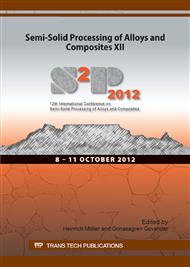p.36
p.47
p.61
p.66
p.72
p.76
p.83
p.89
p.95
The Use of High Pressure Direct Squeeze Casting for Semi-Solid Processing of Aluminum Base Nano Composites
Abstract:
The production of nano-reinforced aluminium alloys in volume and quality suitable for subsequent shape casting has been problematic. Large specific surface area and high interfacial energy of the particles combined with high surface tension of the aluminium melt makes it difficult to add appreciable numbers of particles to the melt, even when later de-agglomerated by techniques such as ultrasonic cavitation. The objective of this work was to develop a technique to incorporate particles using pressure applied while the alloy was in a semi-solid state. The composites produced could be used as a master alloy to inoculate large batches of metal for subsequent casting using any suitable technique. The results show excellent distribution of 50 nm alumina particles in 2014 material. The procedure appears to have broad applicability to a full range of aluminium alloys and particle reinforcements.
Info:
Periodical:
Pages:
72-75
Citation:
Online since:
October 2012
Authors:
Price:
Сopyright:
© 2013 Trans Tech Publications Ltd. All Rights Reserved
Share:
Citation:


